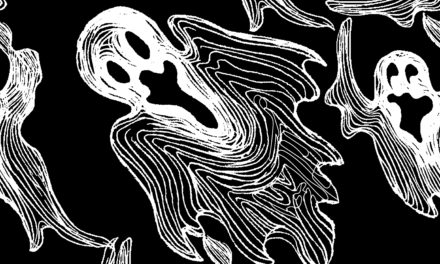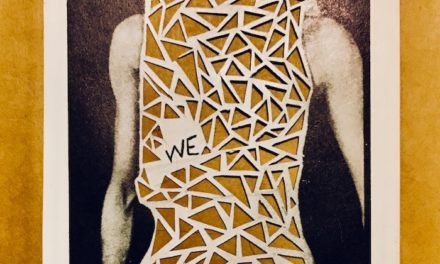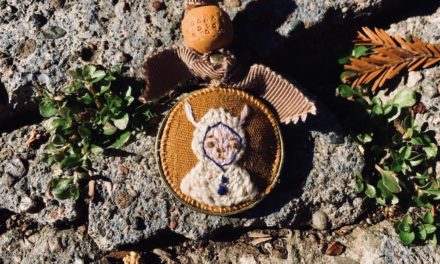Kritik
by Shannon Rampe
Issue 1: Grotesque | 1400 words

The Painter at His Easel by Honoré Daumier
In our once-fair city, there was an owner of a certain gallery, an eccentric named Palaver Williams who prided himself on being more avant-garde than his contemporaries. He wished to “tear out the entrails of art,” or so he claimed in newspaper interviews. We believed he simply enjoyed the notoriety and infamy.
There was an artist in the city named Kritik who had never shown his work. He rarely even ventured outside of his workshop, a musty, fourteenth-century hovel infested with rats. Apart from his neighbors, few of us even knew that Kritik existed. No one claimed to be a friend and he had no known family. None of us knew when he had come to the city, though neighbors later recounted that he had been hiding in the workshop, painting for at least a decade.
Williams learned of this outsider artist, and in a bid to stir up a bit of attention for himself and his gallery, invited Kritik to show his work. Williams posted handbills, gave interviews, sold the showing like a carnival barker.
On opening night, we came pouring in, having read in the papers of this man who painted monstrosities that were “too horrible to look upon.” We came in with our bottles of wine and our autumnal cheer and our knit scarves and manicured hair and our social niceties. We came in smiling and laughing.
Our laughter faltered. Our smiles collapsed. There were a few initial murmurs of “Isn’t that interesting,” or simply gasps of “My God.” Our tight little social structures decayed like rotting wood and broke apart. We drifted into the gallery.
Kritik’s paintings were hideous, appalling things. Sickening shapes lurked within them, writhing angrily and threatening to climb out of the canvas. Kritik’s use of color echoed the darkest subconscious. His lines arched with horrible anticipation. We had seen such things in our darkest nightmares, and blessedly, we had forgotten them upon waking. Now this man, Kritik, had bought them to life on canvas.
Our clusters of conversation deteriorated. Each of us stood in a sphere of our own personal hell, lost in the torments of this painting or that. We tried valiantly to maintain our composure, to pretend that this whole situation was normal. But the disgust, terror, and shame that Kritik’s paintings engendered in us drove us apart, forcing us down inside of ourselves.
Palaver Williams was nowhere to be seen, nor were any of his assistants. The only other inhabitant of the gallery was a man sitting alone on a stool at the back of the gallery, drinking cheap wine from a paper cup, totally undisturbed by the monstrosities surrounding him. Kritik.
Five minutes passed. Ten minutes. Not a word was spoken. The only sounds were the clacking of shoes on the parquet floor and Kritik slurping at his wine like a beast.
A young woman, thin and pretty, with a revealing dress cut from ostrich and burlap, had the gall to approach Kritik. She had large, dark eyes that drank in the nightmares around her. She parted her painted lips to speak and raised a finger, as if to ask a question. Kritik scowled and pointed at the canvas next to him. She turned towards the work.
No word escaped from her lips. Perhaps the sudden transformation in Kritik’s expression from amusement to loathing deterred her. Or perhaps his obscene appearance—the visible odor of his jacket, his filthy, unkempt hair, the pinhole scars outlining his lips—repulsed her. Perhaps she was simply struck dumb by the painting that Kritik sat in front of—a winged, bat-headed clownfish climbing up out of the muck of the artist’s ruined palette, gasping for air and choking miserably. It was impossible to say why she remained quiet.
The door opened and another cluster of patrons came bustling in, laughing and chattering like magpies. Those of us inside turned, the pall momentarily lifted, hoping to be saved from this damnation by those who were entering. Would not someone break this spell? we silently begged. But these new patrons fell still in a matter of heartbeats, struck dumb. And then they, too, were splintered apart by the nightmares they now consciously beheld.
Silence returned. Speech was lost. Each of us became painfully aware of our isolation, the infinite distance between us. No words could bridge that divide, no mere sounds. The gaps between us writhed with unseen tentacles, whispers of murdered children, mutilated corpses. To dare to speak was to offer access to one’s heart to horrors such as these.
Someone across the room—maybe the young woman in the ostrich and burlap coat—began to weep. Kritik smiled.
Her whimpering began softly. Those of us immediately next to her turned away, afraid to admit our own distaste, afraid that her fear and misery were contagious. We were right. It was contagious, only this poor girl wasn’t the source of the disease. We were surrounded by it, and it had already penetrated our minds.
We began crying. One of us fell to the floor and curled into a ball. Another fumbled in her purse for a pill bottle and began to swallow the pills inside, six at a time. Another, a distinguished-looking businessman or a lawyer, perhaps, wrestled the bottle of cheap wine from Kritik’s grip and upended it, drinking the stinking liquid as fast as he could. He vomited on one of Kritik’s works. Kritik didn’t seem to mind.
A woman with sagging jowls and a mink stole sank to her knees in front of one of the paintings, sobbing. She removed a small pistol from her handbag and placed the barrel into her mouth. None of us withdrew. None of us shouted for her to stop. She wrenched back the hammer. We looked on, confused by our feelings of horror and envy.
Kritik clapped his hands and an expression of childlike glee swept over his pocked and hammered face. He was waiting for us to explode into an orgy of suicidal violence, until all of us lay dead. It would prove to be a unique and remarkable mass suicide. Or was it murder?
And then Kritik did something none of us expected. He sprang from his stool and snatched the pistol from the woman’s nearly lifeless hands. Then he shooed us out, driving us into the street like cattle being freed from the slaughterhouse, though inside we were already dead.
Kritik locked the door behind us and switched out the lights. The show was over.
We broke apart like billiard balls, scattering into the night to our homes where we cowered beneath the covers or to bars where we drank ourselves into oblivion, desperate to forget what we had just witnessed.
The next morning, if any of us had wandered past Palaver Williams’ gallery, we’d have seen naked walls. We learned that Williams had hanged himself the night of the opening. No one took up the lease on the gallery and it remained abandoned for years, until the entire building was demolished a decade later to make room for a high-rise office building.
Kritik returned to work in his shop, where the rats cowered in fear. We supposed he continued painting, but he was rarely seen and never interacted with others. One day, several years after the showing, Kritik locked the doors on his little workshop, dropped the key into the sewer, and left with nothing but the clothes on his back. None saw him again.
But his workshop remains undisturbed, lurking in the heart of the city like a cancer, packed with canvasses that hold our night terrors. We avoid it at all costs, but those of us who have occasion to pass by try to laugh it off coolly. We recall the events of that night and try to convince ourselves, during the light of day, that it was all a trick, some mass hysteria that swept over us.
At night, when we wake sweating and gasping for breath, disoriented and terrified, nightmares clutching at our throats, we know better.

Shannon Rampe
Shannon Rampe is a writer, armchair philosopher, and skeptical mystic who has lived in Ohio, Virginia, the U.K., and Washington, D.C. He attended Viable Paradise and Taos Toolbox writing workshops. His work has previously appeared in Abyss & Apex and on the Gallery of Curiosities podcast. Learn more at shannonrampe.com.




